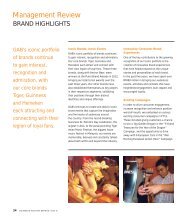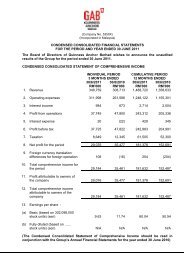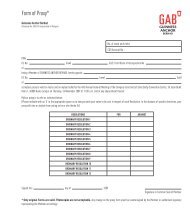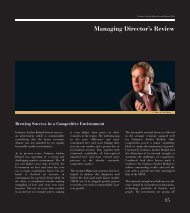Full Version Guinness Anchor Berhad Annual Report 2007 - Gab
Full Version Guinness Anchor Berhad Annual Report 2007 - Gab
Full Version Guinness Anchor Berhad Annual Report 2007 - Gab
- No tags were found...
Create successful ePaper yourself
Turn your PDF publications into a flip-book with our unique Google optimized e-Paper software.
Notes to the Financial Statementsfor the year ended 30 June <strong>2007</strong>2. Significant accounting policies (cont’d)(j)Impairment of assets (cont’d)An impairment loss is recognised if the carrying amount of an asset or its cash-generating unit exceeds its recoverable amount. A cash-generating unit is thesmallest identifiable asset group that generates cash flows that largely are independent from other assets and groups. Impairment losses are recognised in theincome statement. Impairment losses recognised in respect of cash-generating units are allocated first to reduce the carrying amount of any goodwill allocatedto the units and then to reduce the carrying amount of the other assets in the unit (groups of units) on a pro rata basis.The recoverable amount of an asset or cash-generating unit is the greater of its value in use and its fair value less costs to sell. In assessing value in use, theestimated future cash flows are discounted to their present value using a pre-tax discount rate that reflects current market assessments of the time value ofmoney and the risks specific to the asset.In respect of other assets, impairment losses recognised in prior periods are assessed at each reporting date for any indications that the loss has decreased or nolonger exists. An impairment loss is reversed if there has been a change in the estimates used to determine the recoverable amount. An impairment loss is reversedonly to the extent that the asset’s carrying amount does not exceed the carrying amount that would have been determined, net of depreciation or amortisation, if noimpairment loss had been recognised. Reversals of impairment losses are credited to the income statement in the year in which the reversals are recognised.(k)BorrowingsBorrowings are stated at amortised cost with any difference between cost and redemption value being recognised in the income statement over the period of theborrowings using the effective interest method.(l)Employee benefits(i)Short term employee benefitsShort-term employee benefit obligations in respect of salaries, annual bonuses, paid annual leave and sick leave are measured on an undiscounted basisand are expensed as the related service is provided.A provision is recognised for the amount expected to be paid under short-term cash bonus or profit-sharing plans if the Group has a present legal orconstructive obligation to pay this amount as a result of past service provided by the employee and the obligation can be estimated reliably.The Group’s contribution to the Employees Provident Fund are charged to the income statements in the year to which they relate. Once the contributionshave been paid, the Group has no further payment obligations.(ii)Termination benefitsTermination benefits are recognised as an expense when the Group is demonstrably committed, without realistic possibility of withdrawal, to a formaldetailed plan to terminate employment before the normal retirement date. Termination benefits for voluntary redundancies are recognised if the Group hasmade an offer encouraging voluntary redundancy, it is probable that the offer will be accepted, and the number of acceptances can be estimated reliably.<strong>Guinness</strong> <strong>Anchor</strong> <strong>Berhad</strong> (Company No. 5350-X) <strong>Annual</strong> <strong>Report</strong> <strong>2007</strong>104
















